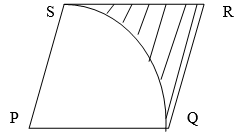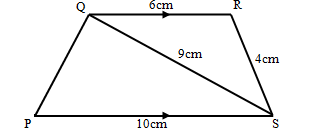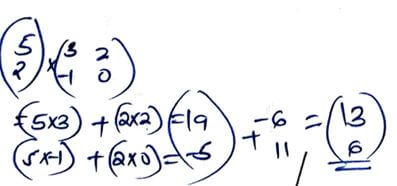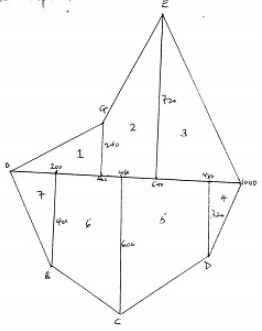QUESTIONS
SECTION A
- The equation of a circle is given by X2 + Y2 – 10Y + 16 = 0.
Find the radius of a circle and its Centre. (4mks) - The point (5,2) undergoes transformation 3 2 followed by translation -6. Determine the Co-ordinates of the image. (3mks)
- Using a ruler and a pair of compasses only construct a parallelogram.
- PQRS in which PQ=6 QR=4 and angle SPQ=75º (3mks)
- Determine the perpendicular distance between PQ and SR. (1mk)
-
- Find the values between 0º and 360º which satisfy the equation 2 Ө = -0.5. (4mks)
- Determine the amplitude, period and phase angle of the following equation. (3mks)
Y = 6 Sin (x/2 – 90)º
- The first term of AP is 2 and the sum of 10 terms of the AP is 650. Find the value of d. (2mks)\
- The figure below shows a rhombus PQRS with PQ= 9cm and ‹SPQ=600. SXQ is a circular arc, centre P.
Calculate the area of the shaded region correct to two decimal places (Take Pie= 22⁄7) (4mks) - Solve the equation 2x2 + 3x=5 by completing the square method (3mks)
- Simplify the expression
3x2 – 4xy2 + y (3mks)
9x2—y2 - Two grades of coffee one costing sh.42 per kilogram and the other costing sh.47 per kilogram are to be mixed in order to produce a blend worth sh.46 per kilogram in what proportion should they be mixed. (3mks)
- Pipe A can fill an empty water tank in 3 hours while pipe B can fill the same tank in 5 hours. While the tank can be emptied by pipe C in 15 hours. Pipe A and B are opened at the same time when the tank is empty. If one hour later pipe C is also opened. Find the total time taken to fill the tank. (4 mks)
- Given that Cos (x – 20)0 = Sin (2x + 32)0 and x is an acute angle, Find tan (x – 4)0 (3 Marks)
- In the figure below PQRS is a trapezium with QR parallel to PS. QR = 6cm, RS = 4cm, QS = 9cm and PS = 10cm.
Calculate- The size of angle SQR (2 Marks)
- The area of triangle PQS (2 Marks)
- Wanza sold a bag of potatoes for Sh. 420 and made a profit. If she sold it at Sh. 320, she could have made a loss. Given that the profit is thrice the loss, how much did she pay for the bag of potatoes? (3 Marks)
- The sum of digits formed in a two digit number is 16. When the number is subtracted from the number formed by reversing the digits, the difference is 18. Find the number (3 Marks)
- Make P the subject of the formula XYP = QPX (3 marks)
- The length and breadth of a rectangular floor garden were measured and found to be 4.1m and 2.2m respectively. Find the percentage error in its area. (3 marks)
SECTION B (CHOOSE 3 QUESTIONS)
- The figure below represents a towel model. The base PQR is an equilateral triangle of side 9cm. The length VP=VQ=VR=20.5cm. Point M is the mid-point of PQ and VM =20cm. Point N is on the base and vertically below V.

Calculate-
- Length of RM (2mks)
- Height of the model (2mks)
- Volume of the model (3mks)
- The model is made up of a material whose density = 2700kg/m3. Find the mass of the model. (3mks)
-
- The table below shows distribution of marks scored in a test by standard eight pupils in a Mathematics test.
Using assumed mean of mark of 57 calculate.Marks
30-34
35-39
40-44
45-49
50-54
55-59
60-64
65-69
70-74
75-79
No. of pupils
1
5
10
10
19
20
8
8
4
3
- The actual Mean of the grouped data. (3mks)
- The standard deviation. (7mks)
- OABC is a parallegram with O(0,0), A(2,0), B(3,2) C(1,2). O1A1B1C1 is the image of OABC under transformation -2 0
0 -2-
- Find the co-ordinates of O1A1B1C1 (2mks)
- On the grid provided draw OABC and O1A1B1C1 (2mks)
-
- Find O11A11B11C11 the image of O1A1B1C1 under the transformation matrix (10 -20). (2mks)
- Draw O11A11B11C11
- Find a single matrix that maps O11A11B11C11 onto OABC. (3mks)
-
- Using trapezium rule find the area bounded by the curve (4mks)
- Y=-X2+6X+1 X=0 and X=6
- Calculate the exact area under the curve. (4mks)
- Find the percentage error introduced by the trapezium rule. (2mks)
-
- Complete the table below, giving the rules correct to 1 decimal place.
XO
0
40
80
120
160
200
240
2SIN(X+20)2
0.7
-
2.0
-
00
-
-2.0
[3 COS X
1.7
1.3
0.9
-1.6
- Using the same scale drawing on X and Y axis draw the graphs of 2sin(x+20) and [3 cos x for 0≤x≤240.
- Using the graphs above determine the values for X which 2sin(x+20)2 =[cosX.
- Determine the difference in amplitude between the two graphs.
- Complete the table below, giving the rules correct to 1 decimal place.
- Three business partners, Bela Joan and Trinity contributed Kshs 112,000, Ksh,128,000 and ksh,210,000 respectively to start a business. They agreed to share their profit as follows:
30% to be shared equally
30% to be shared in the ratio of their contributions
40% to be retained for running the business.
If at the end of the year, the business realized a profit of ksh 1.35 Million. Calculate:- The amount of money retained for the running of the business at the end of the year. (1mk)
- The difference between the amounts received by Trinity and Bela (6mks)
- Express Joan’s share as a percentage of the total amount of money shared between the three partners. (3mks)
- A bag contains 5 red, 4 white and 3 blue beads . two beads are selected at random one after another.
- Draw a tree diagram and show the probability space. (2mks)
- From the tree diagram, find the probability that;
- The last bead selected is red (3mks)
- The beads selected were of the same colour (2mks)
- At least one of the selected beads is blue. 3(mks)
- A surveyor recorded the following information in his field book after taking measurement in metres of a plot.
- Sketch the layout of the plot. 4 mks.
- Calculate the area of the plot in hectares. 6mks
MARKING SCHEME
SECTION A
- The equation of a circle is given by X2 + Y2 – 10Y + 16 = 0.
Find the radius of a circle and its Centre. (4mks)- x2 + y2 = 10y + 25 = -16 + 25
x2 + y2 - 10y + 25 = 9
√(x2) √y2 - 1xy + 25
= √9
Radius = 3 units
x = 0
y = 5
centre -(0,5)
Radius = 3 units
- x2 + y2 = 10y + 25 = -16 + 25
- The point (5,2) undergoes transformation 3 2 followed by translation -6. Determine the Co-ordinates of the image. (3mks)
- Using a ruler and a pair of compasses only construct a parallelogram.
- PQRS in which PQ=6 QR=4 and angle SPQ=75º (3mks)
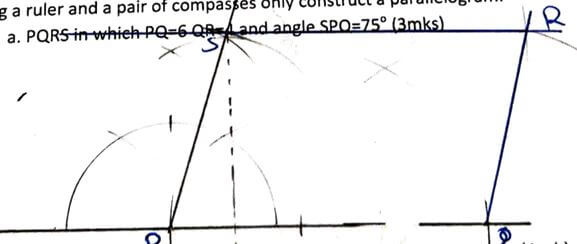
- Determine the perpendicular distance between PQ and SR. (1mk)
- 3.8 ± 0.1 cm
- PQRS in which PQ=6 QR=4 and angle SPQ=75º (3mks)
-
- Find the values between Oº and 360º which satisfy the equation 2 Ө = -0.5. (4mks)
- σsin 20 = 0.5
2σ = 30
= 210/2 and 330/2
= 105º and 165º
- σsin 20 = 0.5
- Determine the amplitude, period and phase angle of the following equation. (3mks)
Y = 6 Sin (x/2 – 90)º- period 360/1/2 = 720
Amplitude = 6
Phase angle = 90/1/2
= 180º
- period 360/1/2 = 720
- Find the values between Oº and 360º which satisfy the equation 2 Ө = -0.5. (4mks)
- The first term of AP is 2 and the sum of 10 terms of the AP is 650. Find the value of d. (2mks)
- Ap = 2
N/2 (2G + (N - 1)d = 650
10/2 (2 x 2 + (10 - 1)d) = 650
5(4 + 9d) = 650
20 + 45d = 650
45d/45 = 630/45
d = 14
- Ap = 2
- Area of the Rhombus = 92 Sin 60° = 70.1481
Area of sector = 60/360 × 22/7 × 92 = 42.4286
Shaded area = 70.1481 − 42.4286
Shaded area = 277195
≅ 27.72 (2dp) - 2x2 + 3x = 5
x2 + 3/2x + (¾)2 = 5/2 + (¾)2
(x+¾)2 = 49/16
x + ¾ = ± √(49/16)
x = − ¾ ± 7/4
x = − 2.5 or x = 1 - 3x2 – 4xy2 + y
9x2—y2
3x2 – 3xy – xy + y2
(3x – y) (3x + y)
= (3x – y) (x – y)
(3x – y) (3x + y)
= x – y
3x + y) - Let the ratio be x:y in kg respectively.
Cost of the mixture = Sh. (42x + 467y)
Total mass of mixture = (x+y)kg
Cost per kg of the mixture = Total cost of the mixture
Total mass
Sh. 46 = 42x + 47y
x + y
46x + 46y = 42x + 47y
4x = y
x/y = ¼ ⇒ x:y = 1:4 - Ratio of work of each pipe
A = 1/3
B = 1/5
C = 1/15
Rate of work of A and B = 1/3 + 1/5 = 8/15 per hr
Work done in 1 hour = 8/15 × 1 = 8/15 of the volume
Volume still empty = 1 − 8/15
= 7/15
Rate of work of A, B & C = 1/3 + 1/5 − 1/15
= 7/15
Time taken to fill = 7/15 ÷ 7/15 = 1hr
Total time = 1 + 1 = 2hrs - Cos(x − 20)° = Sin (2x + 32)°
x − 20 + 2x + 32 = 90
3x + 12 = 90
3x +78
x = 26°
Tan(x − 4) = Tan (26 − 4)
= Tan 22
= 0.4040 -
- 4° = 9° + 6° − 2 × 6 × 9 Cos Q
108Cos Q = 101
Cos Q = 0.9352
Q = Cos−1 0.9352
Q = 20.74° - ∠PSQ = 20.740
Area of triangle PQS = ½ × 9 × 10 Sin 20.74° = 15.94cm2
- 4° = 9° + 6° − 2 × 6 × 9 Cos Q
- HFC 0f 240, 320 and 380
HCF = 2 × 2 × 5 = 20cm
Area = 202 = 400cm2 - Let the digits be x and y
x + y = 16.......(i)
original no. = 10x + y
Reversed no. = 10y + x
(10y+x) − (10x+y) = 18ii
x + y = 16
9y − 9x = 18
9y + 9x = 144
9y − 9x = 18
18x = 126
x = 7
y = 9
The no. is 79 - log x + logyP = logQPX
log x + p log y = px log Q
Log x = px log Q − p Log y
Log x = p(x log Q − Log y)
Log x = p
x log Q − log y -
Maximum area 4015 × 2.25 = 9.3375
Actual area 4.1 × 2.2 = 9.02
Minimum area 4.05 × 2.15 = 8.7075
A.e = 9.3375 − 8.7075
2
= 0.315
% error = (0.315 × 100)%
9.02
= 3.492%
SECTION B (CHOOSE 3 QUESTIONS)
- The figure below represents a towel model. The base PQR is an equilateral triangle of side 9cm. The length VP=VQ=VR=20.5cm. Point M is the mid-point of PQ and VM =20cm. Point N is on the base and vertically below V.

Calculate-
- Length of RM (2mks)
- 7.794 cm
- Height of the model (2mks)
- 19.83 cm
- Volume of the model (3mks)
- Volme = Base area x height
1/3 x 9 x 7.794 x 18.82 x 1/2 = 231.8177 cm3
- Volme = Base area x height
- Length of RM (2mks)
- The model is made up of a material whose density = 2700kg/m3. Find the mass of the model. (3mks)
- mass = volume x density
m = 231.8197 x 2.7 g/cm3
= 625.91 grams or 0.62591 kgs
- mass = volume x density
-
- The table below shows distribution of marks scored in a test by standard eight pupils in a Mathematics test.
Using assumed mean of mark of 57 calculate.Marks
30-34
35-39
40-44
45-49
50-54
55-59
60-64
65-69
70-74
75-79
No. of pupils
1
5
10
10
19
20
8
8
4
3
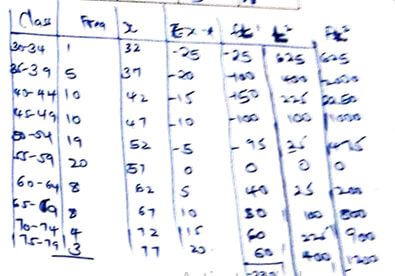
- The actual Mean of the grouped data. (3mks)
- 54.386
- The standard deviation. (7mks)
- 10.002
- The actual Mean of the grouped data. (3mks)
- OABC is a parallegram with O(0,0), A(2,0), B(3,2) C(1,2). O1A1B1C1 is the image of OABC under transformation -2 0
0 -2-
- Find the co-ordinates of O1A1B1C1 (2mks)
- O1 = (0,0)
- A1 = (4,0)
- B1 = -6,-4)
- C1 = (-2, -4)
- On the grid provided draw OABC and O1A1B1C1 (2mks)
- Find the co-ordinates of O1A1B1C1 (2mks)
-
- Find O11A11B11C11 the image of O1A1B1C1 under the transformation matrix (10 -20). (2mks)
- O11 = (0,0)
- A11 = (4,0)
- B11 = -6,-8)
- C11 = (-2, 8)
- Draw O11A11B11C11
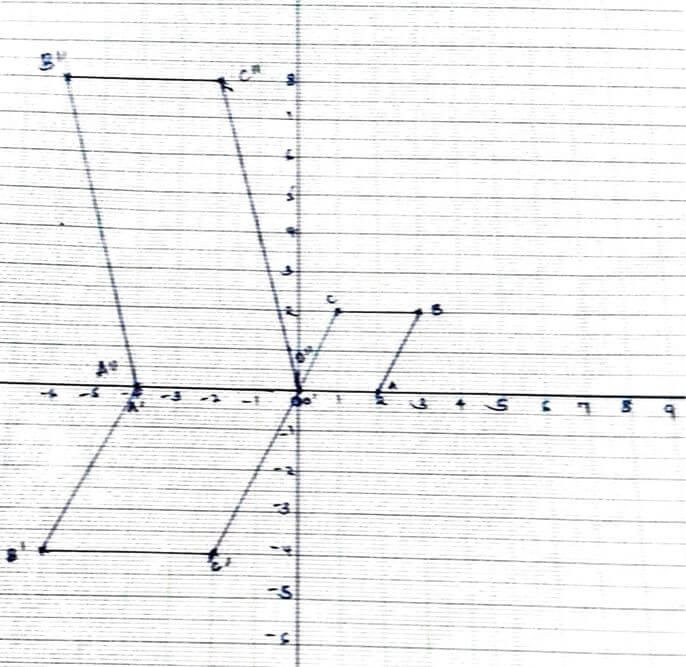
- Find O11A11B11C11 the image of O1A1B1C1 under the transformation matrix (10 -20). (2mks)
- Find a single matrix that maps O11A11B11C11 onto OABC. (3mks)
- =(0.5 0)
(0 0. 25)
- =(0.5 0)
-
- Using trapezium rule find the area bounded by the curve (4mks)
x 0 1 2 3 4 5 6 y 1 6 9 10 9 6 1 - Y=-X2+6X+1 X=0 and X=6
- 1/2n (1 + 1 + 2(6 + 9 + 104 + 9 + 6 + m)
1/2 (2 + 2(40) = 41 square units
- 1/2n (1 + 1 + 2(6 + 9 + 104 + 9 + 6 + m)
- Calculate the exact area under the curve. (4mks)
- 42 square units
- Find the percentage error introduced by the trapezium rule. (2mks)
- 42 - 41
42
1/42 x 100
= 2.38%
- 42 - 41
- Y=-X2+6X+1 X=0 and X=6
-
- Complete the table below, giving the rules correct to 1 decimal place.
XO
0
40
80
120
160
200
240
2SIN(X+20)2
0.7
1.73
2.0
1.3
00
-1.3
-2.0
√3 COS X
1.7
1.3
0.3 0.9
-1.627 -1.6
-0.9 - Using the same scale drawing on X and Y axis draw the graphs of 2sin(x+20) and [3 cos x for 0≤x≤240.
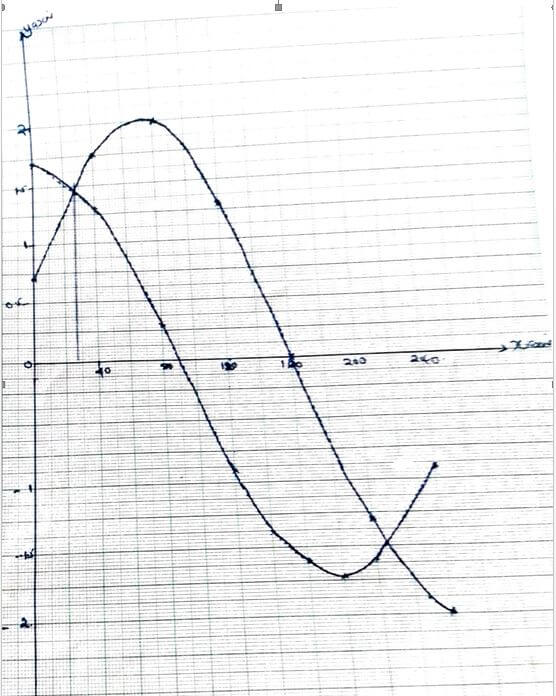
- Using the graphs above determine the values for X which 2sin(x+20)2 =[cosX.
- 27º and 208º
- Determine the difference in amplitude between the two graphs.
- 2 - 1.7 = 0.3
- Complete the table below, giving the rules correct to 1 decimal place.
-
- 40/100 × 1,350,000 = 540,000
- Shared equally = 30/100 × 1350000 × 1/3 = 135000
Ratio 112:128:210
Trinity shared in the ratio
210/450 × 30/100 × 1,350,000 = 189000
Total Trinity's amount
135,000 + 189,000 = 324,000
Bela's ratio share
112/450 × 30/100 × 1350000 = 100800
Total Bela's amount
135000 + 100800 = 235,800
Difference = 324000 − 235800 = 88,200 - Joan's
135000 + 128/450 × 30/100 × 1350000 = 250,20
250200 × 100
(60/100) × 1350000
250,200 × 100
810,000
= 308/9%
-
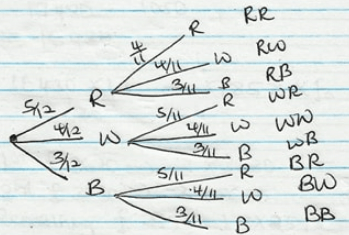
-
- P(RR) or p(WR) or P(BR)
(5/12 × 4/11) + (4/12 × 3/11) + (3/12 × 2/11)
5/33 + 5/33 + 5/44 = 20+20+15
132
= 55/132 =5/12 - P(RR) or p(WW) or P(BB)
(5/12 × 4/11) + (4/12 × 5/11) + (3/12 × 5/11)
20+12+6 = 38 = 19
132 132 66 - P(RB) or p(WB) or P(BB) or P(BW) or P(BR)
(5/12 × 3/11) + (4/12 × 3/11) + (3/12 × 2/11) + (3/12 × 4/11) + (3/12 × 5/11)
15+12+6+12+15
132
= 60/132 =5/11
- P(RR) or p(WR) or P(BR)
-
- 1cm rep 100m
- Area 1 = ½ × 400 × 240 = 48000m2
Area 2 = ½ × 240 × (240+720) = 115200m2
Area 3 = ½ × 360 × 720 = 129 600m2
Area 4 = ½ × 120 × 320= 19200m2
Area 5 = ½ × 400 × (600+320) = 184000m2
Area 6 = ½ × 280× (400+600) = 140000m2
Area 7 = ½ × 200 × 400 = 40000m2
Total area = 48000+ 115200 + 129600 + 19200 + 184000 + 140000 + 40000 = 676,000m2
= 67.6ha
- 1cm rep 100m
Download Mathematics Questions and Answers - Form 4 Mid Term 2 Exams 2023.
Tap Here to Download for 50/-
Get on WhatsApp for 50/-
Why download?
- ✔ To read offline at any time.
- ✔ To Print at your convenience
- ✔ Share Easily with Friends / Students

